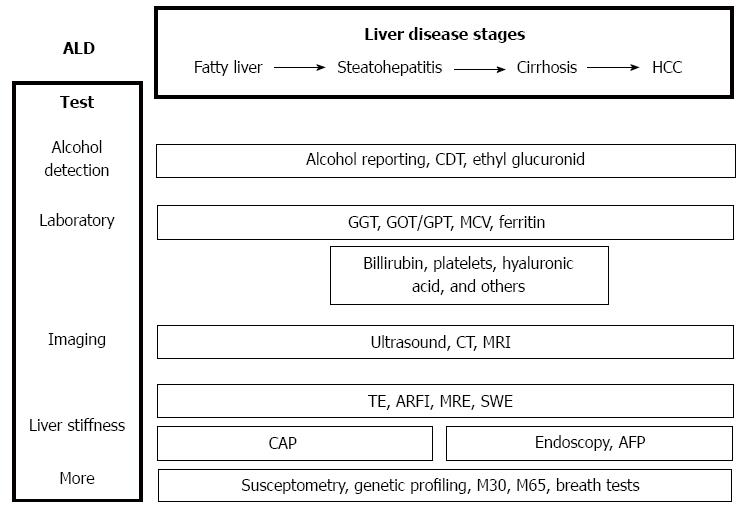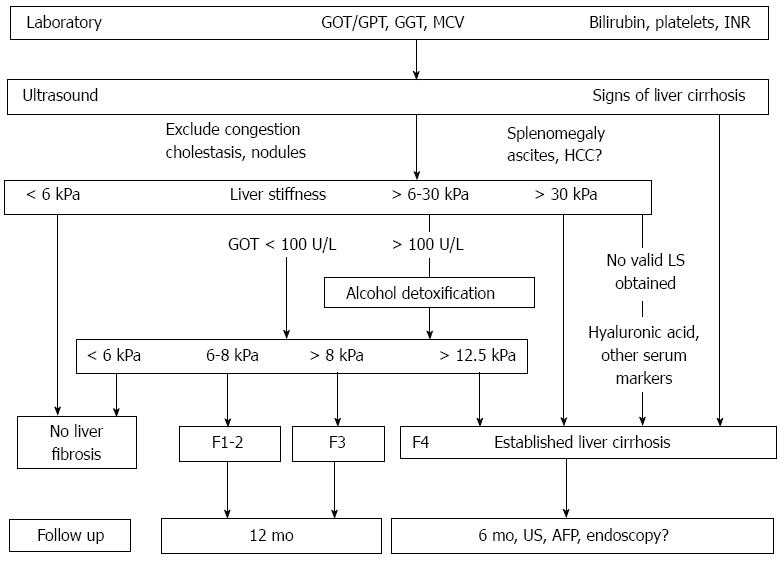Copyright
©2014 Baishideng Publishing Group Inc.
World J Gastroenterol. Oct 28, 2014; 20(40): 14626-14641
Published online Oct 28, 2014. doi: 10.3748/wjg.v20.i40.14626
Published online Oct 28, 2014. doi: 10.3748/wjg.v20.i40.14626
Figure 1 Natural course of alcoholic liver disease and major end points.
HCC: Hepatocellular carcinoma.
Figure 2 General non-invasive approaches for patients with suspected alcoholic liver disease.
Combination of different tests will help to establish alcohol as underlying reason and to assess the stage of liver disease. ALD: Alcoholic liver disease; HCC: Hepatocellular carcinoma; CDT: Carbohydrate deficient transferrin; MCV: Mean corpuscular volume; CT: Computed tomography; MRI: Magnetic resonance imaging; TE: Transient elastography; ARFI: Acoustic radiation force impulse imaging elastography (Siemens); CAP: Controlled attenuation parameter (Echosens); MRE: Magnetic resonance elastography; SWE: Shear wave elastography (Supersonic imaging); GGT: γ-glutamyl transpeptadase; GOT: Glutamic-oxal(o)acetic transaminase; GPT: Glutamate pyruvate transaminase; AFP: α-fetoprotein.
Figure 3 Liver stiffness scale with cut-off values for various fibrosis stages in alcoholic liver disease patients without pronounced inflammation, congestion, tumors or mechanic cholestasis.
Figure 4 Complete non-invasive diagnostic work plan for patients with alcoholic liver disease at Salem Medical Center Heidelberg with follow up.
Flow scheme allowed diagnosis of fibrosis in 95% of patients. In the remaining 5% of patients without valid LS measurements, the role of serum markers need to be settled but single hyaluronic acid looks promising. In patients with LS > 30 kPa, cirrhosis is established despite increased transaminase levels. MCV: Mean corpuscular volume; HCC: Hepatocellular carcinoma; LS: Liver stiffness; US: Ultrasonography; GGT: γ-glutamyl transpeptadase; GOT: Glutamic-oxal(o)acetic transaminase; GPT: Glutamate pyruvate transaminase; AFP: α-fetoprotein.
Figure 5 Clinical significance of synthesis impairment and portal hypertension in cirrhotics.
Both factors are independently and individually occurring in cirrhotic patients and determine the individual risk of severe complications (framed). While synthesis is easily assessed by lab tests, elastographic techniques are the future highly sensitive method of choice to identify patients with portal hypertension. HCC: Hepatocellular carcinoma; SBP: Systolic blood pressure.
- Citation: Mueller S, Seitz HK, Rausch V. Non-invasive diagnosis of alcoholic liver disease. World J Gastroenterol 2014; 20(40): 14626-14641
- URL: https://www.wjgnet.com/1007-9327/full/v20/i40/14626.htm
- DOI: https://dx.doi.org/10.3748/wjg.v20.i40.14626













